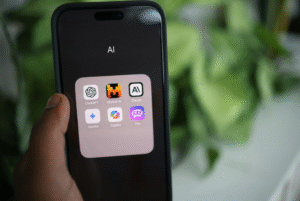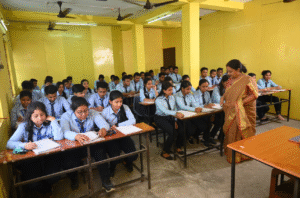
For decades, learning under banyan trees or in modest schoolrooms was the norm across Indian villages. But now, something incredible is stirring, a quiet revolution led by AI. Yes, you get that right. With tools like ChatGPT, even schools without fancy labs or libraries can explore quality education for their students. In this blog, we will discuss how AI in education is reshaping possibilities for rural India and how ChatGPT can play a starring role.
India might boast one of the largest school networks in the world, but rural education still runs on chalkboards, underpaid staff, and patchy access to even basic infrastructure. According to the ASER report, nearly 25% of students in rural areas still struggle to read a standard II-level text. Internet access? Still a luxury in many villages. But that’s exactly where AI in education can shine.
TL;DR
- AI tools like ChatGPT are making quality education accessible even in low-resource rural schools.
- In villages with teacher shortages, AI steps in to explain lessons and keep students engaged.
- Students can now learn in regional languages using tools that adapt to how they speak and think.
- AI is helping rural students prepare for competitive exams without needing expensive coaching.
- Teachers save time with AI-generated lesson plans and can focus more on students than paperwork.
The Role of AI in Education for Rural India

While challenges in rural education have existed for decades, what’s new is the kind of solutions we now have on hand. These tools don’t demand expensive hardware or high-end connectivity to make a difference. Even basic smartphones and patchy 4G are enough to bring real impact when the technology is built with context in mind.
Let’s now explore how AI in education is filling in the cracks in our rural education system.
1. Bridging the Teacher Gap
In some schools across rural India, the bell rings, but there’s no teacher walking in. Maybe they’re away on training; maybe there’s just one for the entire school. And so, kids wait or, worse, lose interest. But learning doesn’t have to pause just because someone isn’t physically present. AI-powered learning tools can step in to guide students, explain concepts, and keep the classroom alive, even when the teacher’s chair is empty.
AI Tools That Help:
- Google’s Read Along uses speech recognition to help kids read out loud in Hindi and English, giving instant feedback and boosting confidence.
- Dost Education enables learning through WhatsApp voice notes, giving parents the power to teach when teachers fall short.
- Avishkaar’s STEM kits offer hands-on experiments and AI learning in a box, ideal for schools with limited resources but big dreams.
2. Overcoming Language Barrier
For many kids in rural India, English isn’t just a subject; it’s a wall. Textbooks feel foreign, and online content sounds nothing like their everyday lives. But what if learning felt more familiar? With ChatGPT and similar tools, students can ask questions in their native language and actually get answers that make sense. No need to “translate” their curiosity; they can just learn in the way they talk.
AI tools that help:
- Bhashini translates educational material into Indian languages like Hindi, Tamil, Assamese, and more, making learning feel personal and local.
- Microsoft’s AI for Literacy supports multilingual learning and offers adaptive reading experiences tailored to the student’s level.
- ChatGPT lets students type their doubts in their regional language or Hinglish and receive simple, relatable responses instantly.
3. Boosting Confidence in Communication
How many times have we heard, “Mera baccha bohot sharmaata hai”? For many students in rural India, public speaking isn’t taught; it’s feared. But now, AI voice tutors and feedback tools are acting like that encouraging elder sibling. They let kids practise talking in English or even Hindi, without judgment. Bit by bit, their speech gets clearer, grammar stronger, and slowly, they build the courage to finally raise their hand in class.
AI tools that help:
- ELSA Speak listens to your English and gives instant, personalised tips to improve pronunciation and fluency.
- Duolingo makes learning vocabulary and sentence structures fun through daily challenges and interactive lessons.
- Ello helps kids read out loud, with an AI guide correcting and encouraging them word by word.
4. Competitive Exam Support
In many rural homes, dreams of becoming a doctor, engineer or civil servant often stay just that, “dreams”. In cities, coaching centres are on every corner. But for students in rural areas, even one good guidebook is a luxury. But AI in education is slowly bridging this gap. It can offer curated content, previous year papers, and even mock tests, all for free or at very low cost. Suddenly, that NEET or UPSC dream isn’t so far-fetched anymore.
AI tools that help:
- ChatGPT helps break down complex topics and answer doubts in seconds.
- Shiksha Copilot (by Microsoft Research India) offers bilingual support and exam-level prep tailored to Indian syllabi.
- Examarly recommends daily learning targets for students prepping for UPSC and SSC exams.
Acing NEET or UPSC is one thing. But if tech interviews are on your radar, this list of Python interview questions for 2025 can give your prep that sharp, competitive edge.
5. Smarter Lesson Planning
Creating lesson plans from scratch every week can drain teachers, especially in rural setups where resources are limited. AI can jump in here like a silent partner, helping draft subject-wise plans, daily class objectives, and even fun activities based on the topic. The best part? It adapts to different boards and languages. This way, teachers can focus more on students than on paperwork.
AI tools that help:
- LessonPlans.ai helps teachers auto-generate ready-to-use lesson plans by grade, subject, and learning goals.
- Google Gemini gives creative class activity ideas and even explains concepts in simple Hinglish.
- ChatGPT is great for generating exercises, worksheets, and quick explanations tailored to student needs.
Remember those group projects where one person did all the work and the PPT looked like it was made in 2005? Not anymore. Check out these free AI tools for PPT that make every idea look like magic on screen.
Advantages of AI in Education in India
AI in education offers numerous benefits that can enhance both teaching and learning experiences. From personalised learning paths to increased accessibility, AI has the potential to transform education in powerful ways. So, let’s understand those one by one:
1. Personalised Learning
- AI can adapt to each student’s unique learning style and pace, ensuring that lessons are not generic.
- It can identify areas where students struggle, offering customised resources and activities to help them improve.
- Through AI-driven assessments, learning paths can be dynamically adjusted, giving each student the support they need to succeed.
- This approach helps create a more engaging and motivating learning environment, where students feel their individual needs are met.
2. Instant Feedback
- AI systems can evaluate student work in real-time, providing quick, actionable feedback that aids in faster learning.
- This immediate feedback loop helps students correct mistakes right away, promoting better understanding and retention of concepts.
- Teachers can use AI tools to spot patterns in student errors, helping them address common struggles in class.
- With AI handling grading for objective tasks, teachers can spend more time on discussions and personalised support.
3. Accessibility
- AI can support students with disabilities through assistive technologies like speech-to-text, text-to-speech, and predictive text, making learning more inclusive.
- It helps students with learning disabilities like dyslexia by providing alternative formats or extra time for tasks, which may not be possible in traditional settings.
- AI-driven platforms can offer multi-sensory learning experiences, combining visual, auditory, and kinesthetic learning aids to cater to various needs.
- These tools ensure that all students, regardless of their abilities, have equal access to educational resources.
4. Administrative Support
- AI automates repetitive tasks such as grading and scheduling, allowing teachers to focus on more important aspects of their role, like teaching and interacting with students.
- It can help with creating personalised lesson plans based on student performance data, saving teachers valuable preparation time.
- AI systems can also handle administrative tasks like student attendance and tracking learning progress, making the classroom run more smoothly.
- Teachers can use AI-powered insights to make data-driven decisions, improving the overall educational experience.
5. Enhanced Learning Materials
- AI tools can generate dynamic learning content, such as personalized quizzes, flashcards, or interactive lessons, to engage students more effectively.
- AI can create visual aids like diagrams, videos, or simulations to explain difficult concepts, making abstract ideas more tangible.
- With the help of AI, educators can rapidly develop high-quality teaching resources, saving time and ensuring materials are up to date.
- The integration of AI can also promote creativity in how subjects are taught, using techniques like gamification or interactive storytelling to make learning fun and engaging.
Sure, the benefits sound amazing. But is it really all that simple? You can call us ‘clichés’, but every coin has two sides. So, are you ready to explore the disadvantages?
Free Downloadable Guide for Top AI Tools for Classroom
Real Challenges in Bringing AI to Rural Schools

Sure, AI in education sounds like the hero rural education has been waiting for. But even the best tools can fall flat if the ground beneath isn’t ready. Before we talk big reforms, it’s important to get real about what’s holding us back. Here’s a list of challenges you can expect:
1. Lack of Digital Infrastructure
AI needs more than good intentions. It needs working computers, electricity, and smart devices, things that are still missing in thousands of government schools. Some schools don’t even have working fans, let alone tablets or projectors.
2. Unprepared Teaching Staff
Even if AI tools are handed over, who’s going to show the teachers how to use them? Many teachers haven’t received proper digital literacy training themselves. Expecting them to guide students through AI platforms without support isn’t just unfair; it’s unrealistic.
3. Budget Constraints
Public schools in rural areas often run on shoestring budgets. With funds already stretched for midday meals, repairs, and desks, allocating money for AI tools feels like a big ask. Without dedicated funding, even the most impactful AI solutions can’t reach those who need them most.
4. Resistance from Parents and Communities
AI still feels like a “city thing” to many rural parents. When they haven’t used tech themselves, it’s tough to trust a chatbot or voice assistant with their child’s learning. There’s also a constant fear: will this replace teachers? Will it confuse kids? Until awareness spreads, the trust gap remains real.
5. No Clear Policies or Roadmap
The government is talking about AI in education, but where’s the actual blueprint? Without a clear policy that supports rural schools with funding, infrastructure, teacher training, and evaluation, the idea stays stuck on paper. And rural schools, once again, get left behind.
While AI tools offer academic support, they also open the door to learning on topics often skipped in traditional classrooms, like mental well-being or sex education. Curious about how schools and parents can start that conversation too? Explore our guide on Sex Education for Teenagers.
Final Thoughts
The gap between rural and urban education in India has never just been about marks; it’s about opportunity, confidence, and voice. AI in education won’t fix everything, but it gives us new ways to try. And maybe, just maybe, that’s where hope lives, in trying differently. In listening to what students need, not just what the system demands.
Have you seen any local school, NGO, or teacher using AI tools in unique ways? Or do you have an idea that could make learning easier for rural kids? Share it in the comments; we’d love to know what’s working and what could be.
FAQs
1. What is an AI in Education book?
An AI in Education book explores the intersection of artificial intelligence and the educational system. It discusses AI technologies like machine learning, natural language processing, and data analytics, and how these technologies are reshaping learning environments, teaching methodologies, and administrative functions.
Key books in this field include “Artificial Intelligence in Education” by Wayne Holmes and “” by Ben Williamson, which offer insights into both theoretical frameworks and practical implementations of AI tools in schools.
2. How can AI be used in education?
An essay on AI in education would explore the multifaceted role AI plays in modern classrooms. The focus would be on how AI technologies, such as personalised learning platforms, virtual assistants, and automated grading systems, are enhancing education. The essay could discuss the potential of AI to cater to individual learning needs, improve student outcomes, and streamline administrative functions.
However, it would also address the ethical concerns of AI implementation, such as privacy risks, the digital divide, and the need for teachers to maintain a human touch in the learning process.
3. What are some examples of AI in education?
AI is changing education through tools that personalise learning, detect plagiarism, and provide real-time feedback. Here are some prominent examples of AI applications in education:
- Squirrel AI: An AI-powered tutoring system that adapts to each student’s learning style and pace, providing personalised support in subjects like mathematics and science.
- Turnitin: A plagiarism detection tool powered by AI that scans student submissions for copied content and offers suggestions for improving originality.
- DreamBox: An adaptive learning platform for K-8 students in subjects like math that uses AI to provide real-time feedback and adjusts the difficulty level based on student responses.
- Quizlet: AI-enhanced study tools that offer personalised flashcards and quizzes, helping students learn more effectively.
- IBM Watson Education: A platform that helps teachers by providing data-driven insights and resources tailored to individual student needs and performance.
4. Are there any AI in education courses available?
Yes, numerous platforms offer courses on AI in education. Some popular ones include:
- Coursera: Offers courses like “AI in Education” that cover how to integrate AI into the classroom and how it can be used to support personalised learning.
- edX: Features programs like “Artificial Intelligence in Education” that explore AI’s role in reshaping learning environments, from adaptive learning systems to AI-powered assessments.
- Udemy: Offers more practical courses that focus on using specific AI tools in education, including machine learning applications for teaching and educational software development.
- LinkedIn Learning: Offers courses designed for educators to learn about AI tools and how to use them to enhance their teaching.






